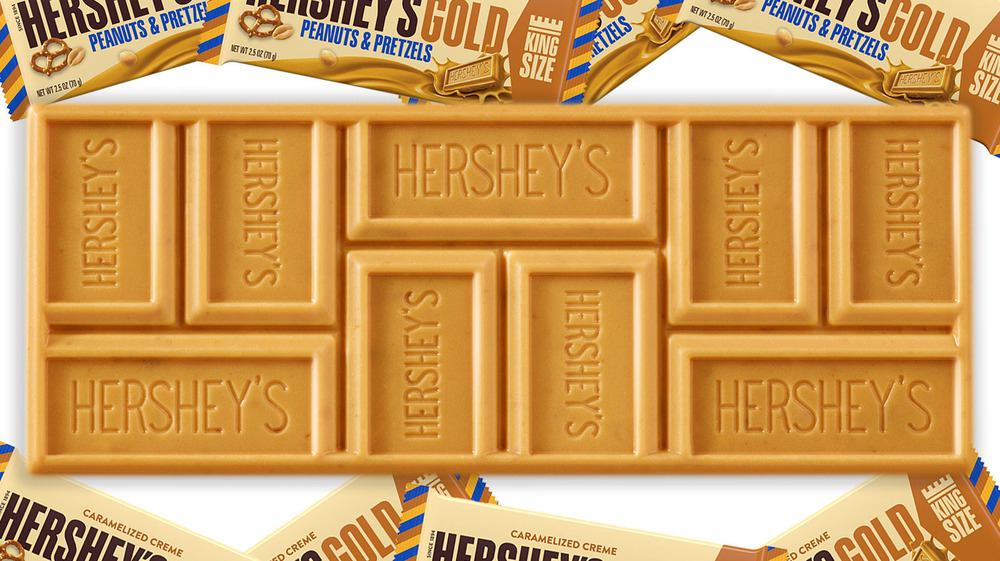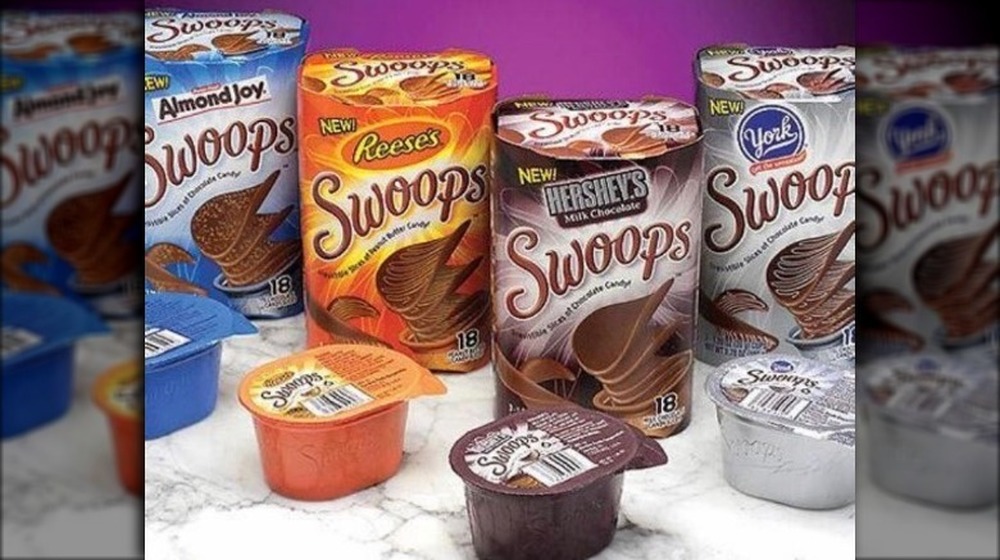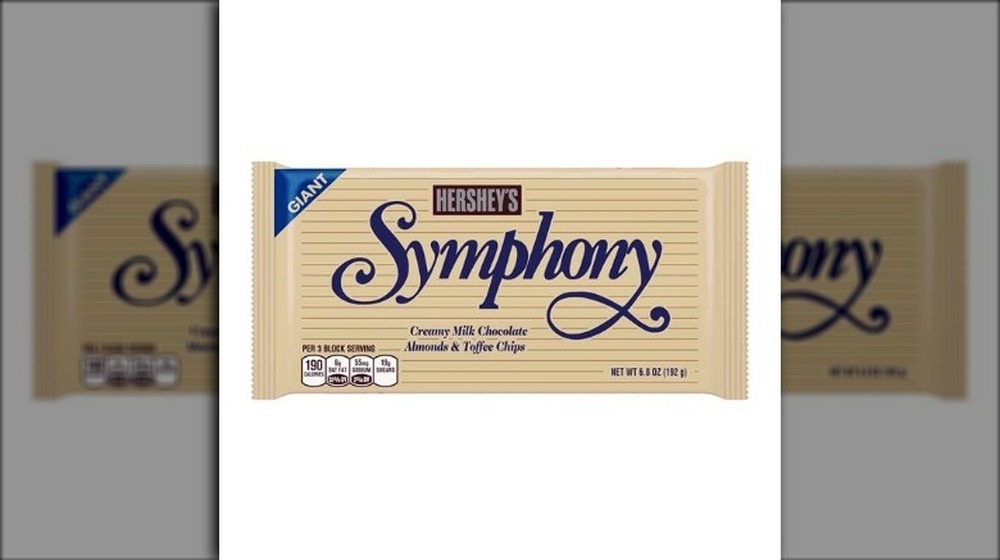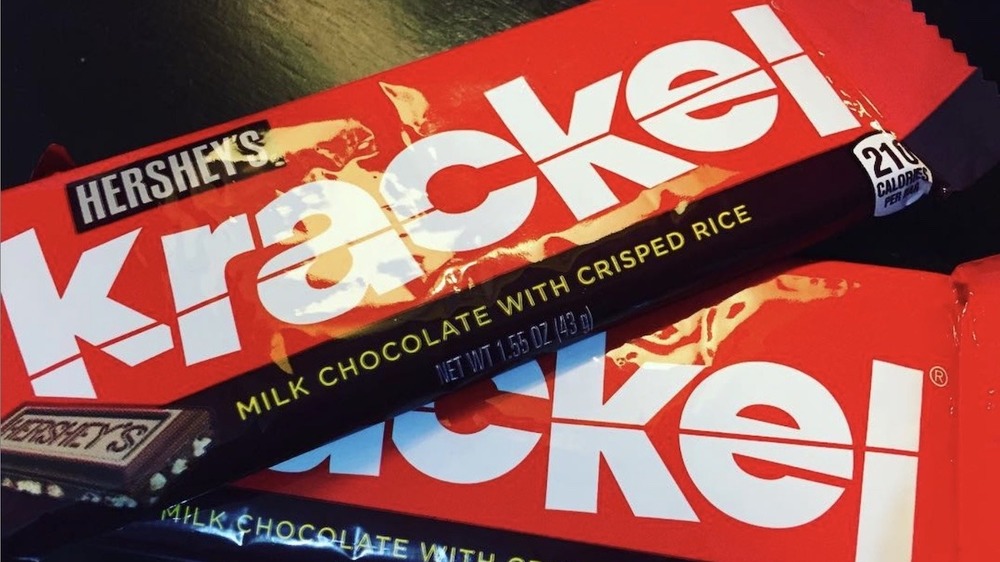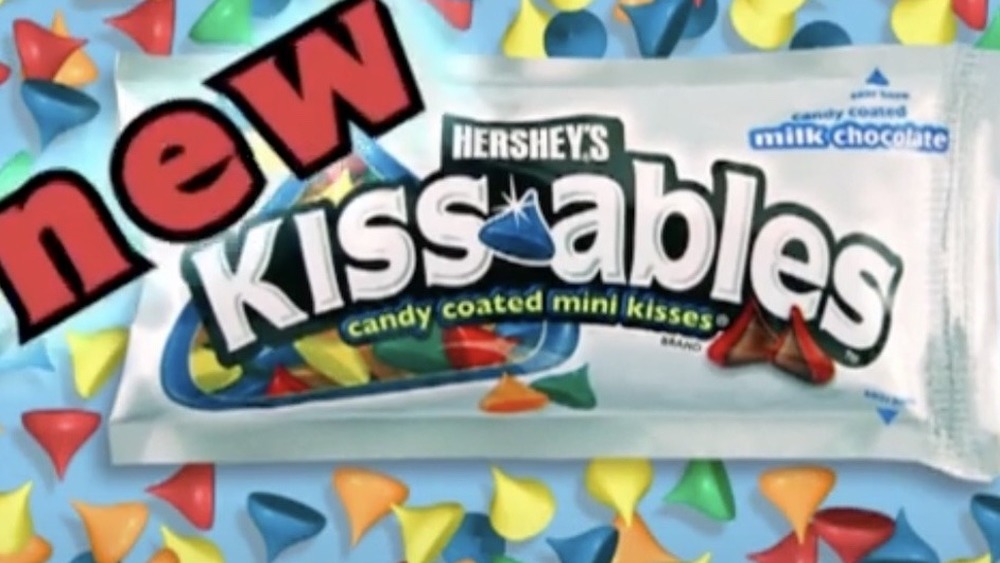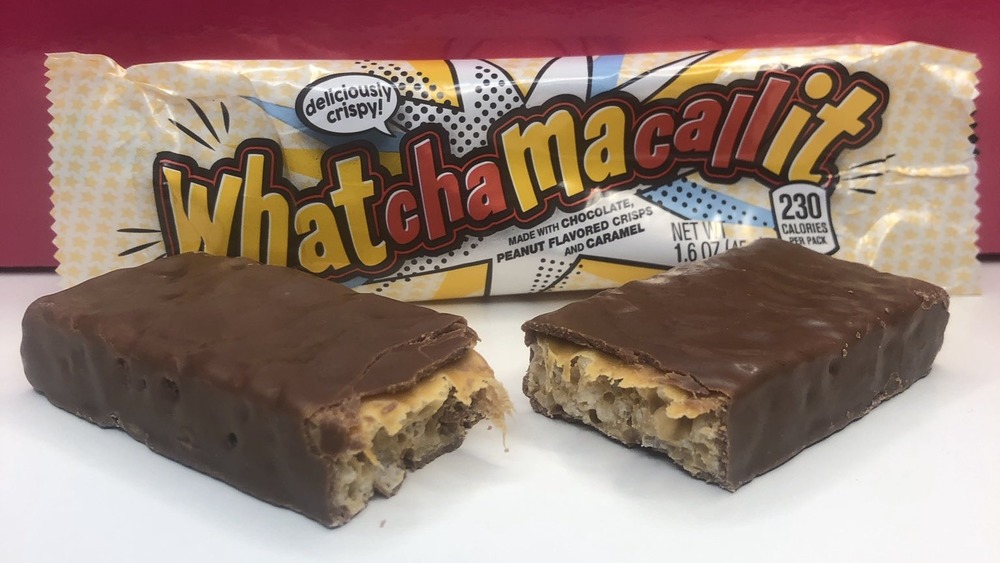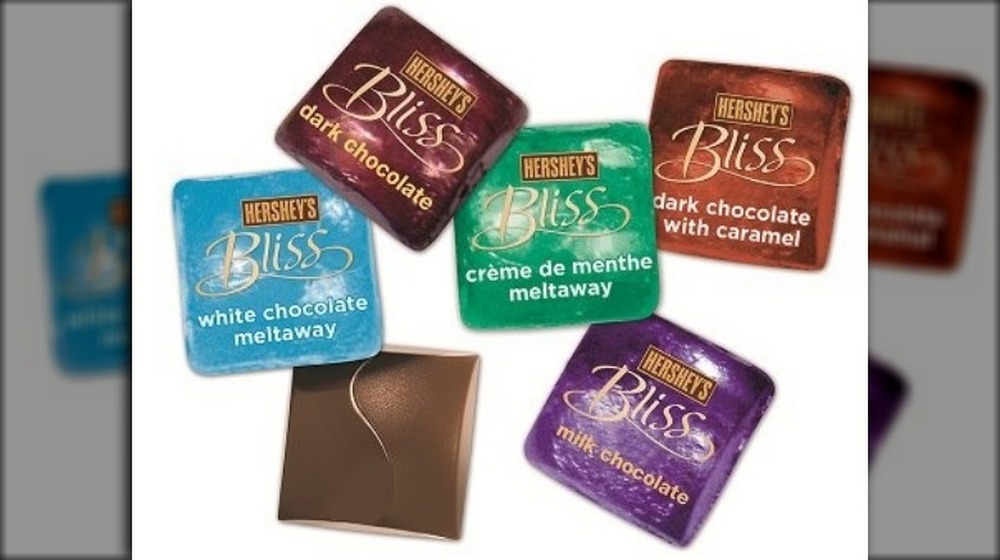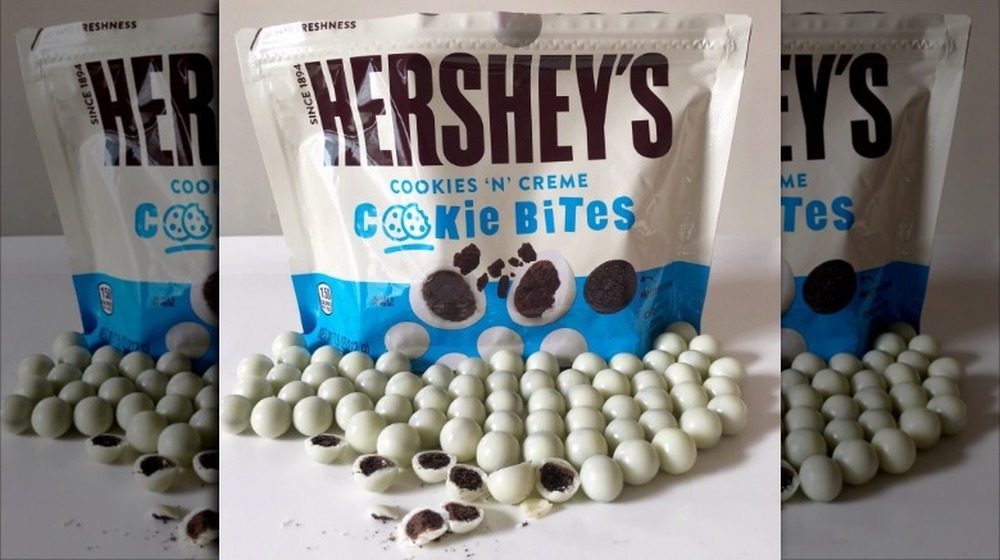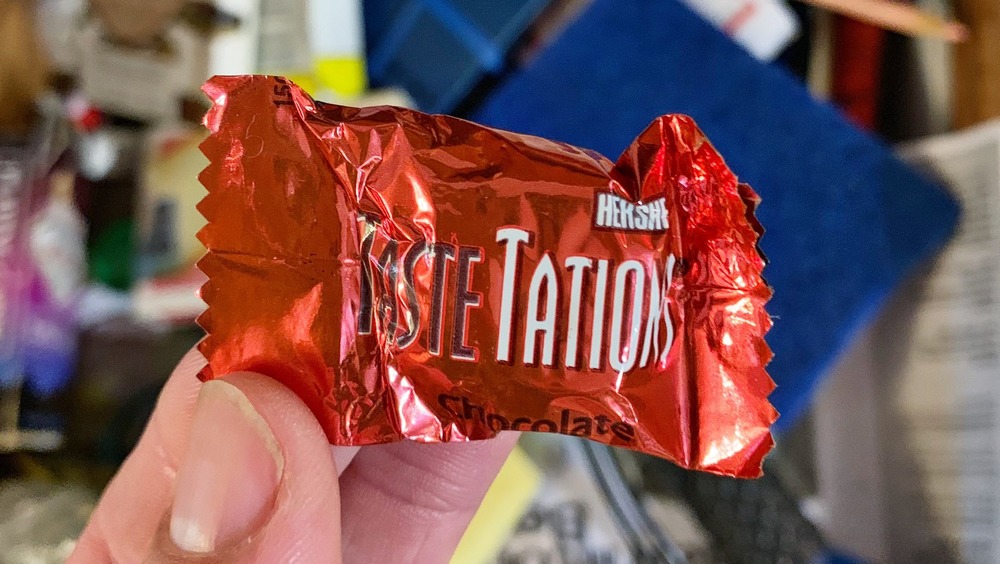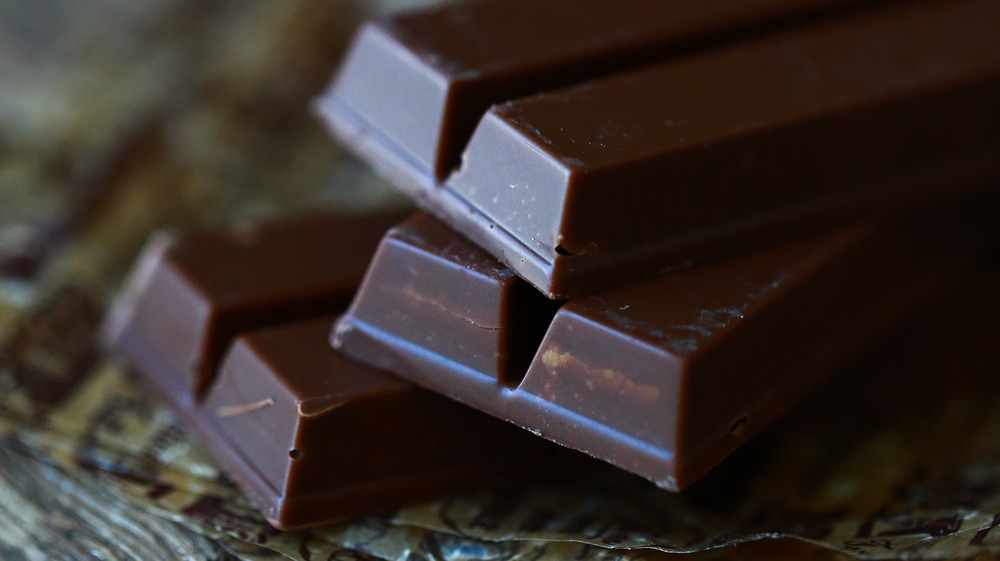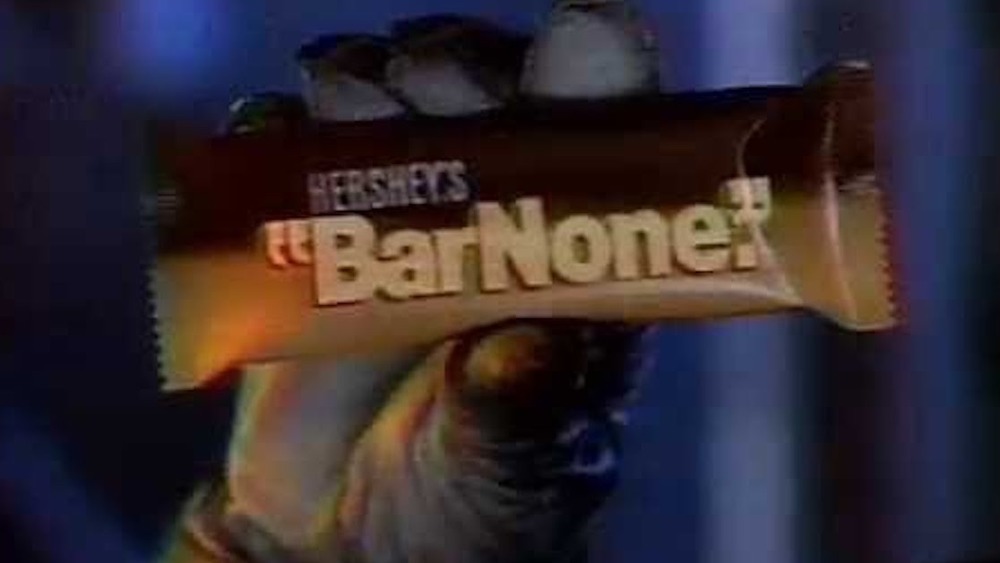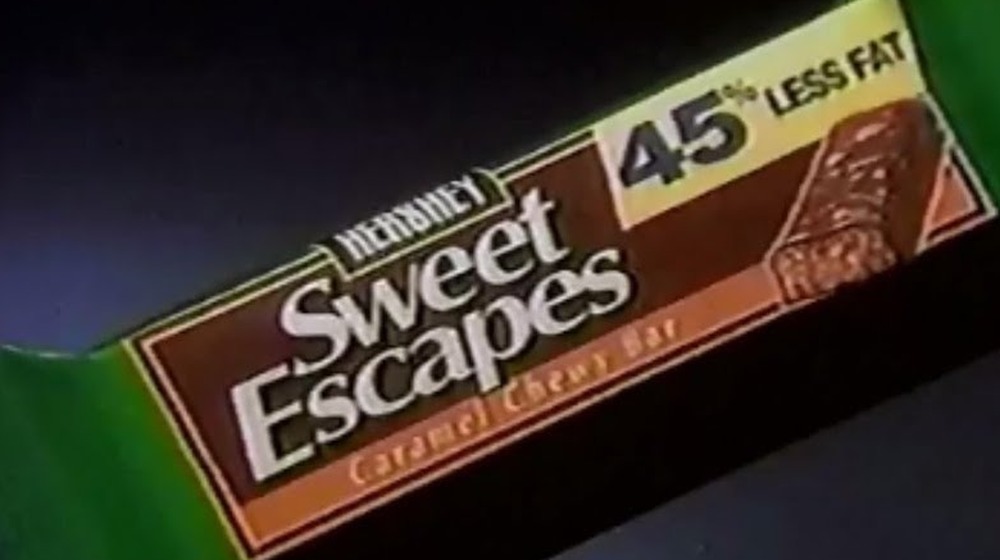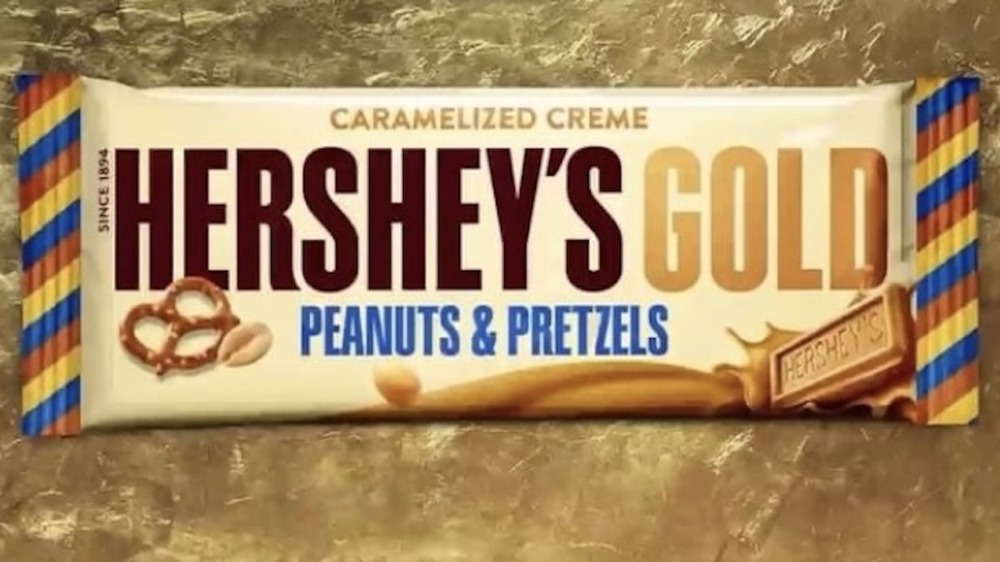Hershey's Candies That Totally Flopped
Candy, especially chocolate, can have a powerful hold on a person. Not only does it taste good, but it's sweet, creamy, and velvety, to name just a few of its qualities. But a chocolate bar can also unwrap lots of deeply-held feelings. Chocolate is a celebration food, and comfort food, a treat for a job well done, or a simple pleasure to take the edge off of a bad day. For these reasons and more, most everybody has their favorite candy bar. That's likely the same one they've had for years, possibly dating back to childhood.
This emotionally-driven brand loyalty means it's very difficult for a new candy bar to make it. With dozens of options at a drug store, supermarket, or newsstand, it's already a crowded market. With everyone having a go-to favorite, new candy and chocolate treats barely stand a chance amongst the masses. Not even ones with the full marketing, production, and chocolate-making weight of the Hershey company behind them can necessarily last for very long. Here are some products from the world's most famous chocolate company that, unlike stars like Reese's Peanut Butter Cup, Kit Kat, Mr. Goodbar, and the Hershey Bar itself, didn't make such a sweet impact.
Swoops swooped in, and then swooped out
Over the years, Hershey's has produced a number of candy bars with something inside, like nuts, nougat, peanuts, or fruit. But sometimes the star of the show is the company's famous chocolate, which is by now intensely familiar to the average American palate. In 2003, Hershey's launched a product that consisted of little more than its original milk chocolate but in a whole new form as hyperbolic parabaloids. As Interesting Engineering reports, that means the chocolate was Pringles-shaped. That was the whole gist of Hershey's Swoops. Along with the original variety of chocolate chips — not potato chips, but slices of chocolately goodness that resembled potato chips — Hershey's offered Swoops in flavors like York Peppermint Patty, Almost Joy, and Reese's Peanut Butter Cup. Despite offering an "indulgent, mouth-melting experience" (via SixthSeal), Swoops were swept out of stores in 2006, just three years after their introduction.
According to Fast Company, Swoops were over-priced and overpacked. A standard, 3.78-ounce box contained three separate cups of Swoops, each holding six slices. That made for just 18 thin pieces of chocolate for a standard retail price of $1.79, which could buy at least a couple of regular old Hershey bars.
Before Symphony there were some other creamy Hershey chocolates
Toffee and chocolate pair well together. Whether that pairing arrives as a teeth-achingly sweet homemade treat or is enjoyed in the form of a Heath or Skor bar, the combination of smooth chocolate and hardened, buttery sugar go together like chocolate and peanuts, or chocolate and caramel. Since the late 1980s, Hershey has sold a product called Symphony, pitched as a slightly higher-end, notably creamier bar, complemented with almonds and toffee bits. This specific chocolate bar format was launched after five years of research, according to Hershey's. In fact, nearly the same bar debuted a couple of times before under different, more descriptive names with far less success.
In 1934, Hershey unveiled the Mild and Mellow bar, the "mild and mellow" phrase signifying to consumers that this was creamier, smoother chocolate than what they'd find in the standard Hershey bar. Hershey's pulled it off the market at the end of 1941 because it had to, as the U.S. had entered World War II and nationwide sugar rationing went into effect. In the mid-20th century, the smooth and toffee-loaded Butter Chip failed to make much of an impression, reports Classic Candy, but Hershey's threw tiny versions into bags of its Miniatures product for many years.
How Krackel cracked
First of all, Hershey's Krackel is hardly rare or obscure. A near-identical candy to the standard Nestle Crunch bar, a Krackel was made up of toasted rice and firm milk chocolate, although the bar was thinner and the rice reportedly just a little bit crunchier than what one could find in a Crunch (via Whatever Happened to Pudding Pops). For decades they were a reliable and tasty member of the Hershey's Miniatures family, alongside shrunken samples of Hershey Bars and Mr. Goodbar.
Unlike its bagged brethren, however, a full-size Krackel bar was often a rarity, making it the crispy, chocolatey unicorn of mass-market candy. They did exist, but just weren't as widely available as Hershey's other well-known candy varieties. Evidently, the world got enough Krackel through the Miniatures method, because Food Dive reported that Hershey ended production of all non-tiny Krackel bars by the early 2000s. The discontinuation didn't last forever, because Hershey caved to demand and brought Krackel back in 2014.
The public kissed off Kissables
Most everyone can agree on Hershey's Kisses. The bite-sized dollops of chocolate are a tiny, tasty treat that isn't going to ruin anyone's diet, plus they look so inviting sitting in a big bowl on an office worker's desk, or given out as prizes by teachers, or playing "We Wish You a Merry Christmas" in that perennial holiday commercial we've all assuredly seen at least once in our lives.
Hershey's didn't need to mess with what makes Kisses so great, but they did anyway with a variety of Kiss flavors. At least one time it worked, in the form of Hugs, which swirl milk and white chocolate around each other. One time it didn't work, as in the case of the ill-fated Kissables. In 2005, Hershey's introduced the product, which were miniaturized Kisses, covered in a rainbow of candy shells, ostensibly to go to war with Mars' top-selling M&M's, as per Fast Company. Regular Kisses have lasted for more than a century, and M&M's for 80 years.
The candy's quick demise may have had something to do with Hershey reformulating the product in 2007. In order to cut costs, the company cut cocoa butter out of the recipe and subbed in less expensive fats. Not only did that noticeably change the taste, but it so altered the chemical makeup of the product that the FDA wouldn't allow Hershey's to say Kissables were made from "milk chocolate" anymore, but rather the vague and unseemly "chocolate candy."
Of Whatchamacallits and Thingamajigs
Spinoffs are the name of the game in television, as when The Simpsons came from The Tracey Ullman Show and Cheers begat Frasier, for example. Unsurprisingly, they are in big candy, too. Many candy bars have been variations of each other, or given rise to another, similar product. Without Reese's Peanut Butter Cup, there would be no Reese's Pieces, for instance. Meanwhile, M&M's has launched all kinds of variants, including ones made with peanuts, peanut butter, and mint.
Even Hershey's Whatchamacallit, the candy bar with the funniest name to say and hardest to spell, had a cousin that proved to be as sweet, complicated, and stuffed with ingredients as its predecessor. In 2009, per Snack History, Hershey unveiled the Whatchamacallit spinoff, which couldn't have been called anything other than Thingamajig. While Whatchamacallit consisted of peanut-flavored crispy wafers and caramel, covered in chocolate, Thingamajig offered cocoa crisps instead of peanut ones, and peanut butter créme instead of caramel. Despite packing more chocolate into a chocolate bar, Thingamajig was not a rousing success, and by 2012, Hershey had quietly stopped making and marketing the product.
Hershey's Bliss was a major miss
Hershey competitor Mars controls the Dove line of chocolates, marketing them as a high quality, premium chocolate — in other words, better than the stuff Hershey and Mars sell on the rack by the cash register in thousands of stores around the U.S. Dove's portion sizes further the notion that their chocolate is just too good and too sophisticated to wolf down — it's sold in small bars and in bags of individually wrapped morsels, inviting chocolate-lovers to just a few satisfying, indulgent bites.
It's chocolate for grown-ups, in other words, and that was a market segment Hershey's aimed to take back in 2008 with the introduction of its Bliss line of chocolates (via CandyBlog). Like Dove, they arrived individually wrapped and sold by the bag, and candy fans could choose from three varieties: Smooth and Creamy Milk Chocolate, Rich and Creamy Dark Chocolate, and Milk Chocolate Meltaway. Hershey's failed to take down Dove and, soon enough, Bliss had not-so-blissfully disappeared.
Hershey's couldn't get enough people to bite on Bites
It's much easier to market a new, improved, or altered version of an existing product than it is to launch a new one. This explains why an extremely popular movie will get a sequel, a beloved TV show from the past will get a reboot, and why Hershey's has reshaped and repackaged many of its most famous and best-selling products into all sorts of newfangled candy permutations.
According to the Hershey Archives, the chocolate maker unveiled Bites in the early 2000s. Rather than chocolate in bar form, Bites were marble-sized chunks of candy, sold in a small, tube-shaped bag. All of the big players were ultra-miniaturized and sold in pebble form in a sack, including Reese's Peanut Butter Cup, Rolo, and York Peppermint Patty. By 2006, the experiment of making candy bars into candy balls was over, with most of the initial line on the way to discontinuation. However, Hershey's held on to the "Bites" idea, later relaunching a series of chocolate-covered things that have stuck around so far, including cookie pieces and pretzels.
Unlike other hard candies, TasteTations didn't linger
There are so many ways to consume chocolate that the business-conscious Hershey's has provided numerous methods by which people can get chocolate into their bodies. Those who like to bite and chew their chocolate can do so with any of its many bars, in miniature, regular, or king sizes. If drinking chocolate is your thing, Hershey's sells a chocolate syrup that mixes into milk. But for those who wanted to suck on chocolate as if it were a hard candy, like they would do to a Jolly Rancher or lollipop, Hershey's readied TasteTations.
Supermarket News reported that the company's first-ever hard candy hit stores in the summer of 1996 and was sold in four flavors: chocolate, caramel, peppermint, and butterscotch. Hershey's launched a massive marketing campaign for TasteTations, which including print and TV advertising (likening its product to the similarly named Motown act the Temptations) and handing out free samples in stores across the country (via Supermarket News). The company even attempted to build interest with a lower than usual price point, selling variety packs with all four flavors for just 25 cents. Ultimately, TasteTations was discontinued, writes blog SoYummy, as the product simply couldn't compete with the other hard candies already available.
Before there was Kit Kat, there was Biscrisp
Kit Kat is a titan of candy bars. It's a tightly packed set of four solid, connected bars of sweet milk chocolate hiding layered wafers and more chocolate inside. Unlike many of Hershey's classic concoctions, the Pennsylvania chocolate company did not create the Kit Kat. Instead, U.K.-based candy maker Rowntree's has the honor, says Mental Floss, debuting the first version of the bar in 1935.
In 1938, according to the Hershey Archives, Hershey's contracted with Rowntree's to create a Kit Kat-like product for the American market. That candy bar, also consisting of chocolate-covered wafers, was labeled the Biscrisp. Having not devised the bar itself, Hershey's technicians had a hard time replicating the manufacturing process Rowntree's pioneered. The wafers tasted and baked up differently because they were made with American flour instead of English flour, which proved to be distinct enough to significantly alter the candy, no matter how much Hershey's followed the recipe.
Eventually, candy buyers liked the product enough to make it a decent seller upon its debut in 1938, but Hershey's grew so frustrated with making the Biscrisp that it ended production on it after just one year. Nevertheless, in 1969, Hershey's wished to return to the idea of chocolate-covered wafer bars. This time, they made a licensing arrangement with Rowntree's to make and market Kit Kat in the United States.
Bar None was a misfire for Hershey's, bar none
A name like "Bar None" suggests a simple candy bar, one that consisted of little more than just chocolate. But this 1980s-era Hershey product wasn't that at all. Instead, it was stacked and complicated, with milk chocolate covering chocolate-flavored wafers, chocolate creme, and peanuts. Imagine a Kit Kat, but with chocolate-flavored wafers, and with the addition of nuts. Advertisements claimed that Bar None would "tame the chocolate beasty within," as it offered up cocoa flavor on the inside and outside, says Classic Candy. Chocolate is extremely and almost universally popular in the U.S., and Hershey's seemingly gave the people what it wanted, stuffing three different types of the confection into one treat.
According to Candy Blog, the Bar None hit American stores in 1987, simultaneously debuting in Canada as the Temptation bar. Hershey's kept the product in circulation for five years before reformatting and reformulating it, making it two small sticks instead of one big bar and adding caramel. Those changes didn't save Bar None, however, as Hershey's discontinued it in 1997.
Sweet Escapes was a lower-fat treat that consumers quickly abandoned
Chocolate bars are a lot of things, but one thing they're generally not is diet food. The taste and texture of a chocolate bar are the results of a unique combination of fat and sugar. Not coincidentally, many diets encourage their adherents to eschew one or both of those things. Sure, there are and have been plenty of low-sugar, low-fat chocolate bars on the market, but they don't quite taste the same as the full-calorie varieties. Meanwhile, sugar substitutes used may cause moderate to severe gastrointestinal distress, as Livestrong reports.
Yet, if a company were to somehow concoct a line of reduced-fat chocolate bars that also tasted fantastic and didn't mess with everyone's stomachs, they'd stand to make untold riches. In 1996, it looked like the chocolate royalty at Hershey's may have unlocked the secret of dietetic chocolate with Sweet Escapes, at least according to a report from Deseret News. Sold in bags of individually-wrapped, smaller-than-standard-size chocolate bars, Sweet Escapes were made with about
Sales were initially strong for Sweet Escapes and other low-fat candies. By 1999, Hershey's had discontinued some products in the Sweet Escapes line because the entire segment of diet-friendly chocolates had quickly cratered, proving to be little more than a food fad. "It has a market, but you're not going to get anybody who wants a Snickers to switch over to a Sweet Escape," a grocery wholesaler told Supermarket News.
Hershey's Gold wasn't worth much
While it's sold scores of different chocolate treats over the last century, the flagship Hershey bar line has remained a decidedly small and exclusive club. In late 2017, according to Spoon University, the chocolate maker released only its fourth "official" Hershey Bar: Hershey's Gold. It was made out of "caramelized creme" with pieces of pretzels and peanuts added to the mix. There was nothing that could chemically or legally chocolate be considered chocolate in Hershey's Gold, as its primary ingredients were sugar, vegetable oil, and milk — and no cocoa or cocoa butter.
Hershey's was a sponsor at the 2018 Winter Olympics, according to Delish, where it heavily promoted Hershey's Gold before and during the quadrennial athletic event. As per Thrillist, the company staged a massive giveaway and product familiarization event in tandem. Every time an athlete representing the U.S. won a gold medal, Hershey's planned to award thousands of coupons for free Gold bars via social media, as many as 150,000.
How did it taste? According to Brand Eating, the Hershey's Gold bar was creamy, salty, very sweet, and a little bit like caramel (which is itself just well-cooked sugar, after all). That big, mighty debut, didn't turn Hershey's Gold into a long-term contender. A Redditor who toured the Hershey facility in spring 2020 and enquired about their availability of the Hershey's Gold bar was told the candy was no longer in production.
